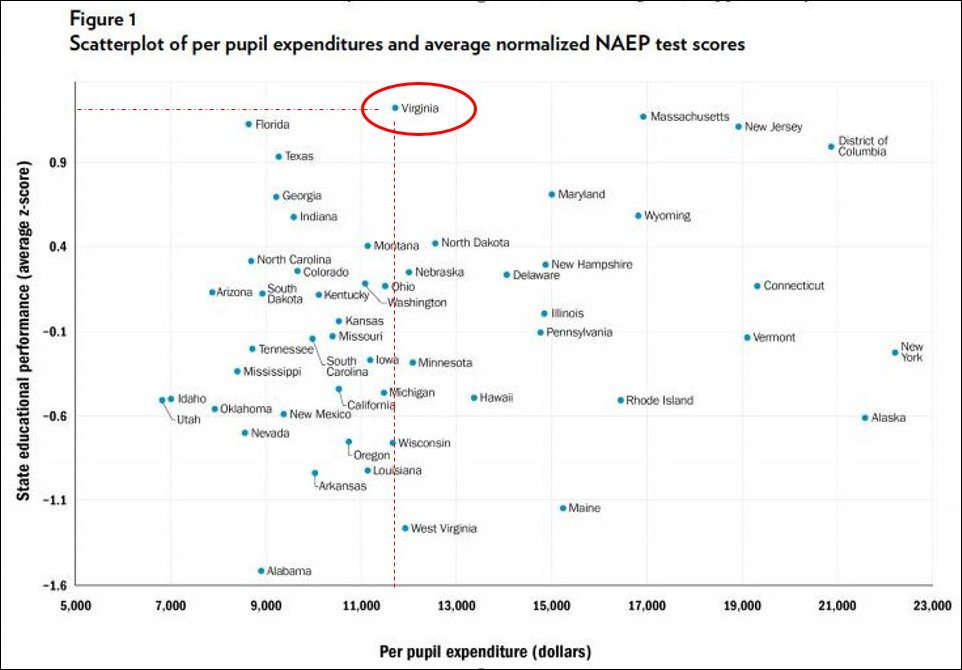
Which states have the best public education systems in the country? By most rankings, Virginia scores fairly well. U.S. News & World-Report puts Virginia in the No. 12 spot. Education Week grades Virginia B-, considerably better than the national score of C. Forbes ranks Virginia 6th in the nation (7th in quality and 2nd in safety). Given all the scandals and problems we have identified here on Bacon’s Rebellion, it’s frightful to contemplate that Virginia has one of the better public school systems in the country. I shudder to think what’s happening in other states’ schools systems. But the state rankings make it clear that things could be worse… a lot worse.
Now comes a report by the libertarian Cato Institute, which places Virginia at the top of the heap. While Cato’s results undercut the Bacon’s Rebellion narrative that Virginia public schools are badly in need of reform, Cato’s methodology strikes me as valid.
Rather than mix inputs (such as spending per pupil) and outputs (such as standardized test scores), Cato focuses on outcomes only, using National Assessment of Educational Progress (NAEP) test scores as the raw material. The study ignores indicators such as pre-school enrollment, graduation rates and college attendance, which may be a function of factors unrelated to learning, and relies upon the standardized NAEP scores to gauge actual achievement. Cato also recognizes that the populations of the 50 states vary widely by race, ethnicity and socioeconomic background. Thus, a state like Iowa with a predominantly white population will generate higher average NAEP scores than an ethnically diverse state like Texas with large African-American and Hispanic populations, but lower scores don’t necessarily mean that Texas schools are doing a worse job of educating their students. Do Iowa whites outperform Texas whites? Do Iowa blacks outperform Texas blacks? Fortunately, NAEP data provides the data to make apples-to-apples comparisons. When Cato takes these into account, the state rankings change markedly.
Virginia is a fairly ethnically and socioeconomically diverse state, so when Cato adjusts for heterogeneity, its quality ranking rises to No. 1 in the country.
The Cato study makes another important adjustment. It correlates academic outcomes with money spent per student. New York spends the most money per student ($22,232), almost twice that of the typical state. “Yet,” says Cato, “that massive expenditure results in a rank of only 31. … Tennessee, on the other hand, achieves a similar level of success (ranked 30th) and spends only $8,739 per student. Although the two states appear to have education systems of similar quality, the citizens of Tennessee are getting far more bang for the buck.”
When states are ranked on the basis of heterogeneity, expenditures, and Cost of Living, Florida and Texas shoot to the top of the list, but Virginia still scores a highly respectable No. 3, making it the 7th most “efficient” state in the country.
When cost of living is taken into account, Cato finds, “no significant relationship is found between spending and student performance, either in magnitude or statistical significance.” That’s not to say spending levels have no effect, rather that “most states have reached a sufficient level of spending such that additional spending does not appear to be related to achievement as measured by these test scores.”
Other findings: Stronger teacher unions are correlated negatively with rankings. Cato speculates the reason is that unions are associated both with higher pay and expenditures and with their ability to thwart the removal of under-performing teachers. On the other hand, having a greater share of students in charter schools is positively related to student achievement — although the strength of the relationship is not strong. Cato finds that teacher-pupil ratios and the percentage of students in private schools have no meaningful bearing on educational outcomes.
Finally, Cato cautions that schools differ widely from district to district within state public school systems. “We generally dislike the idea of painting the performance of all schools in a given state with the same brush. However, state-level rankings do provide an intuitively pleasing basis for lawmakers and interested citizens to compare state education policies.”
Bacon’s bottom line: Ranked by educational value added, it’s fair to say that Virginia has one of the best public school systems in the country. Seeking continual improvement and a better deal for taxpayers, Bacon’s Rebellion tends to dwell on the warts and scabs — and we will continue to do so. But let us pause for a moment and credit our teachers, principals and educational administrators for the work they do. Caught between federal, state, and local imperatives, a swelling population of economically disadvantaged students, growing percentage of students with disabilities, and the often-unrealistic demands of parents, they have a thankless job. But they do it better than most.
Update: Larry Gross reminded me of a Cato oversight that’s big enough to undermine all of its findings. The article does not appear to adjust for the percentage of students taking the NAEPs. In some states, testing is mandatory. In Virginia it isn’t.
Update to the update: NAEP bases its state-to-state comparisons on representative samples of students in all states, says Charles B. Pyle, VDOE director of media relations. Thus, the comparisons are valid, Cato did not commit an oversight, and Virginia’s outcomes do look pretty darn good.

Leave a Reply
You must be logged in to post a comment.